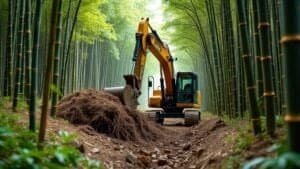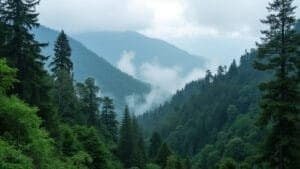Altitude plays a defining role in shaping the natural habitat of red pandas. These elusive mammals are found in the high mountain forests of the Eastern Himalayas and southwestern China, inhabiting elevations typically between 7,200 and 15,700 feet (2,200 to 4,800 meters). Within this altitudinal range, red pandas find the cool, moist climate and dense vegetation necessary for survival, particularly the bamboo that makes up the majority of their diet
The forest ecosystems at these heights are uniquely structured, offering both food and shelter in the form of mixed coniferous and broadleaf trees, steep slopes, and moss-covered canopies. Altitude influences everything from temperature and humidity to vegetation type and predator presence, ultimately shaping how and where red pandas live, forage, and reproduce
In this article, we’ll explore how elevation impacts red panda habitats, focusing on vegetation, climate, landscape features, and the ecological constraints that define their geographic range
How Altitude Shapes Red Panda Habitat and Behavior

Red pandas are true mountain dwellers, with every aspect of their life intricately tied to the altitudinal gradient of their native Himalayan and Chinese forests. The elevation at which they live not only influences their climate exposure but also determines the availability of food, water, shelter, and escape from predators. Altitude isn’t just a feature of their environment—it is a central factor in defining the ecological niche they occupy
Elevation Range Where Red Pandas Thrive
Red pandas are most commonly found between 7,200 and 15,700 feet, or approximately 2,200 to 4,800 meters, depending on the region. However, their core elevation range—where they are most frequently observed—is slightly narrower, typically around 2,800 to 3,600 meters. This range provides the optimal balance of temperature, vegetation, and microclimatic stability necessary for their daily survival
According to elevation distribution data published on ResearchGate, red panda presence peaks between 2,800 and 3,200 meters. At elevations above 3,600 meters, sightings and population density tend to decline significantly. This suggests a clear preference for mid-elevation forest zones, where food is abundant and conditions are neither too cold nor too exposed
Lower elevation limits, closer to 2,200 meters, often overlap with human settlements or agricultural lands, increasing the risk of habitat degradation and disturbance. On the upper end, higher elevations may support less bamboo or be seasonally covered in snow, limiting food availability and access to shelter
Climate Conditions at High Altitudes
The high-altitude zones that red pandas inhabit are characterized by cool temperatures, high humidity, and frequent fog or mist. As elevation increases, temperature drops at an average rate of roughly 3.5°F for every 1,000 feet of elevation gain. This creates a naturally air-conditioned habitat where daytime highs remain mild even in summer, and winters bring manageable cold rather than severe extremes
These conditions support a forest microclimate that retains moisture, slows decomposition, and fosters a lush understory of bamboo. Snowfall during winter helps recharge soil moisture and feed mountain streams, which red pandas rely on for hydration. The persistent cloud cover in many red panda habitats—especially in regions like Yunnan and Sikkim—reduces solar radiation, further stabilizing temperature and preventing drought stress
According to the Smithsonian’s National Zoo, this climate also contributes to the thick, mossy forests that red pandas call home, creating a humid, shaded environment that supports both their arboreal movement and thermoregulation
Altitude and Bamboo Growth in Mountain Forests
Bamboo is not just a preferred food—it is the backbone of the red panda’s ecological niche. The specific species of bamboo that red pandas eat, such as Yushania and Arundinaria, are altitude-sensitive and grow best within the same mid-elevation bands that red pandas occupy. These bamboo varieties flourish under the cool, shaded conditions found beneath the canopy of high-altitude forests, particularly between 2,500 and 3,500 meters
As altitude increases, bamboo growth can become sparser and slower, especially above the tree line where the canopy disappears and soil becomes rocky or frozen. At lower altitudes, bamboo may be more susceptible to harvesting by humans or competition from livestock grazing. Thus, the sweet spot for bamboo—and consequently for red pandas—is clearly altitude-dependent
This co-occurrence of red panda habitat and bamboo availability is no coincidence. Habitat suitability models, such as those analyzed in ScienceDirect, show that elevation is one of the most predictive variables in determining red panda presence. This is not only because it affects temperature and precipitation, but because it determines whether the key plant species they depend on can survive and regenerate
Vegetation and Landscape at Red Panda Elevations

The altitudinal zones where red pandas are found are not only defined by their climate but also by a specific vegetation profile and physical landscape that together support the species’ arboreal, solitary lifestyle. These mountain forests are uniquely structured and highly biodiverse, making them some of the most ecologically significant environments in Asia
Tree and Plant Species in High-Altitude Forests
The tree composition in red panda habitats varies slightly by region, but in general, these forests consist of a mix of broadleaf deciduous and evergreen coniferous trees. Common broadleaf species include oak, maple, birch, and rhododendron, while the conifers most often found include fir, hemlock, and spruce. These forests support rich vertical layering, allowing red pandas to sleep high in the canopy and move through trees with minimal exposure to the forest floor
Mosses, lichens, and ferns grow abundantly on tree trunks and rocks, sustained by the high humidity levels of the region. These plants contribute to the forest’s insulating quality, creating a cool, shaded environment that protects against both heat and wind. The forest understory, dominated by species of bamboo such as Yushania and Arundinaria, provides not only food but also ground-level cover for red pandas when they descend from trees
This dense, multi-strata vegetation offers red pandas the essential combination of canopy shelter, food accessibility, and concealment from predators. According to studies compiled in ScienceDirect, red pandas are most commonly found in areas with a high degree of vertical complexity and bamboo dominance, especially within 100 meters of water sources
Terrain Features Supporting Red Panda Ecology
Red panda habitats are situated in steep, rugged mountain landscapes. The terrain typically includes slopes, ridges, and valleys that create microhabitats with distinct temperature and moisture regimes. These features help to shape plant communities, influence bamboo growth, and guide water flow—all of which are critical to red panda survival
Steep slopes and rocky outcrops offer elevated nesting sites and vantage points, while valleys provide natural drainage systems that support streams and rivers. Red pandas often select home ranges near these water sources, minimizing the distance they must travel for hydration. The altitude-driven topography also reduces human access, providing a natural refuge from agricultural expansion and development, which tend to be more intense at lower elevations
The irregular terrain facilitates the formation of cloud forests, especially on the southern-facing slopes of the Himalayas. These forests are perpetually misty, with consistent fog cover that helps preserve moisture levels and promotes the kind of lush plant growth red pandas rely on
How Temperature and Humidity Influence Survival
Red pandas are physiologically adapted to cold, humid environments. Their dense fur, which even covers the soles of their feet, helps them retain body heat during winter months at high altitudes. Unlike many mammals, red pandas have a relatively low metabolic rate, meaning they do not require excessive caloric intake to maintain body temperature. This adaptation aligns well with the bamboo-based diet they consume, which is low in nutrients and energy
Temperature at high elevations rarely exceeds 75°F (24°C), even in summer, and often drops below freezing during winter. These conditions keep disease-causing bacteria and parasites in check, reduce food spoilage, and maintain the overall stability of the habitat
Humidity plays a vital role in sustaining bamboo and other food sources, as well as in maintaining the structural integrity of the forest. Constant moisture supports plant life and helps mitigate the effects of drought and extreme temperatures. It also reduces the risk of wildfires, which could otherwise devastate these slow-recovering ecosystems
Together, the temperature and humidity at these altitudes create an environment where red pandas can thrive with minimal physiological stress, relying on stable, year-round conditions to support their food intake, activity patterns, and reproduction
Ecological Constraints of Elevation on Red Pandas

While altitude provides red pandas with a protective ecological niche, it also imposes specific constraints on their distribution and survival. The narrow elevational band where red pandas thrive limits their ability to adapt to environmental change and increases their vulnerability to habitat fragmentation, climate shifts, and human encroachment. Understanding these constraints is essential for designing effective conservation strategies that take elevation-specific variables into account
Limitations of Altitudinal Habitat Zones
Red pandas are restricted to a very specific elevation range—typically between 7,200 and 15,700 feet—because their survival depends on the microclimatic and vegetative conditions found only within this narrow band. Unlike generalist species that can inhabit a wide variety of altitudes, red pandas are altitudinal specialists
This specialization means that suitable habitat is limited not just by geography, but by elevation. Forests that are too low may be too warm, fragmented by agriculture, or devoid of key bamboo species. Forests that are too high may lack canopy trees, suffer from prolonged snow cover, or offer insufficient bamboo nutrition, especially in winter. The result is a narrow vertical zone that supports red pandas, creating what conservationists call an “elevational squeeze”
In many parts of their range, red pandas are already forced into smaller fragments within this altitudinal zone due to logging, road construction, and land conversion. These human disturbances compress red panda populations into increasingly isolated pockets, making gene flow and population recovery more difficult
Impact of Climate Change on Altitude-Driven Ranges
Climate change adds another layer of complexity to the elevation-based constraints red pandas face. As global temperatures rise, the cool habitats red pandas depend on are gradually shifting upward. This “elevational migration” compresses the zone of suitable habitat, forcing red pandas to either adapt, relocate, or face local extinction
The problem is that there is a limit to how high forests—and the bamboo within them—can grow. As the elevation increases, the tree line gives way to alpine meadows or rocky outcrops that cannot support the dense vegetation red pandas need. Once their preferred habitat moves beyond the top of the mountain, there is nowhere left to go
Additionally, warming temperatures at existing altitudes can stress bamboo species, altering their growth cycles and reducing nutritional quality. Unseasonal droughts, irregular snowmelt, and changing monsoon patterns may further degrade these ecosystems. Studies published in ScienceDirect have modeled the future distribution of red panda habitat and predict substantial losses in elevation-suitable areas under various climate scenarios
Conservation Focus on Elevation-Specific Forests
Given these constraints, conservation efforts must prioritize preserving and restoring forests within the red panda’s core elevation range. This involves protecting both the vertical structure of forests and the altitudinal corridors that allow red pandas to move between elevations in response to seasonal or climate-driven changes
Protected areas and wildlife corridors must be designed to span a gradient of elevations, not just fixed zones. This approach ensures that as the climate shifts, red pandas have options to relocate without losing access to food and shelter. Reforestation projects must also consider elevation-specific vegetation, using native bamboo and tree species that are adapted to the target altitudinal zone
Local communities play a key role in this process. In countries like Nepal and India, community forest initiatives have shown that sustainable management of mid-elevation forests can benefit both biodiversity and human livelihoods. These efforts can help maintain the quality and continuity of red panda habitat across the altitudinal bands where they are most successful
By focusing conservation strategies on elevation-specific dynamics—both biological and climatic—stakeholders can improve the long-term viability of red panda populations and preserve the fragile mountain ecosystems they call home












